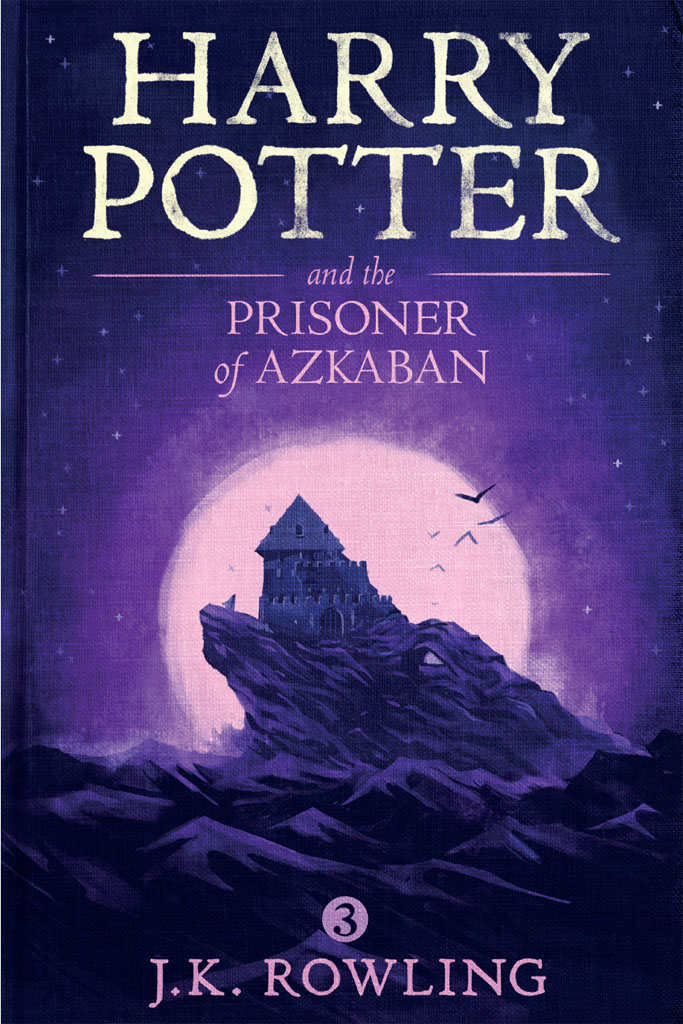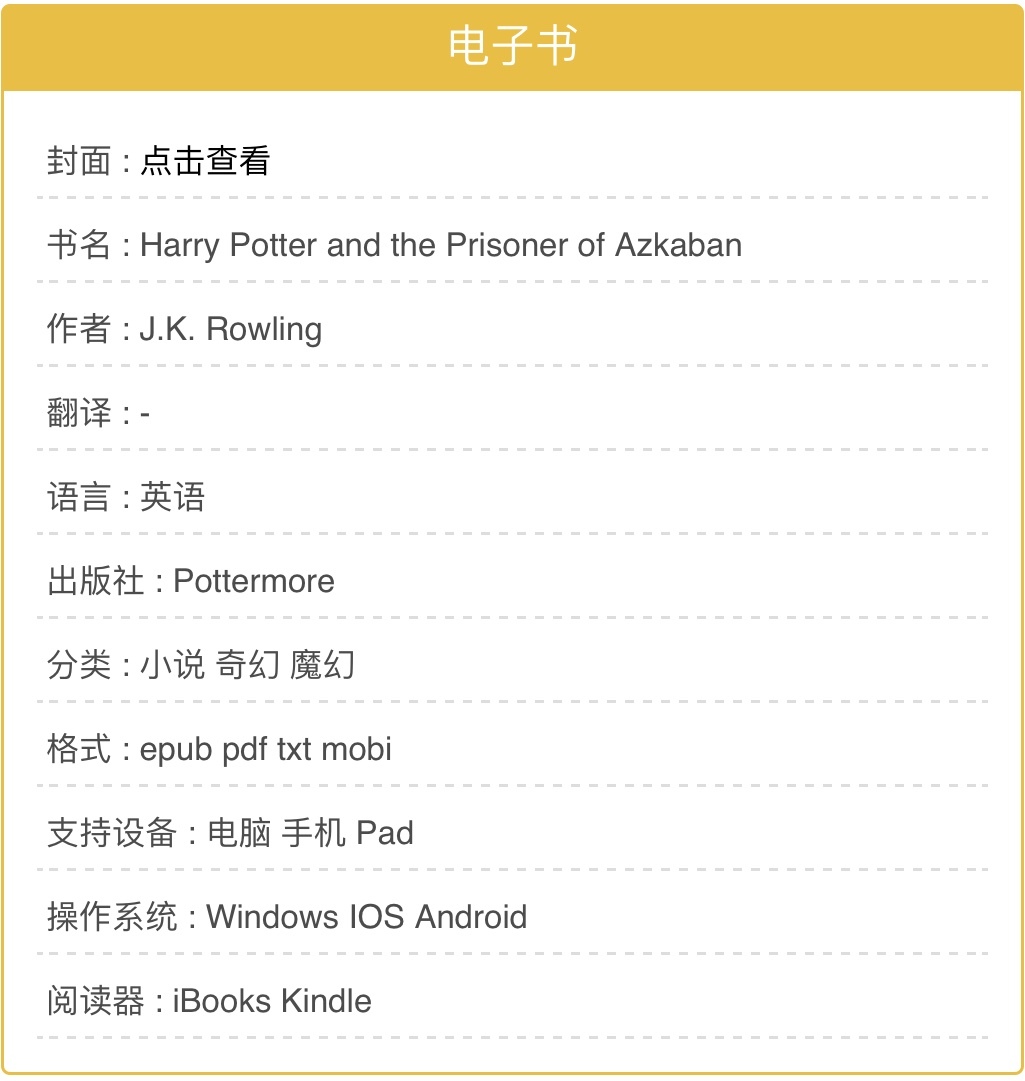
世界村·数字图书馆
官网:iBook.yuyang.org
扫二维码下载电子书


<< 滑动查看下一张图片 >>
Contents
Chapter 1 Owl Post
Chapter 2 Aunt Marge’s Big Mistake
Chapter 3 The Knight Bus
Chapter 4 The Leaky Cauldron
Chapter 5 The Dementor
Chapter 6 Talons and Tea Leaves
Chapter 7 The Boggart in the Wardrobe
Chapter 8 Flight of the Fat Lady
Chapter 9 Grim Defeat
Chapter 10 The Marauder’s Map
Chapter 11 The Firebolt
Chapter 12 The Patronus
Chapter 13 Gryffindor versus Ravenclaw
Chapter 14 Snape’s Grudge
Chapter 15 The Quidditch Final
Chapter 16 Professor Trelawney’s Prediction
Chapter 17 Cat, Rat, and Dog
Chapter 18 Mooney, Wormtail, Padfoot, and Prongs
Chapter 19 The Servant of Lord Voldemort
Chapter 20 The Dementor’s Kiss
Chapter 21 Hermione’s Secret
Chapter 22 Owl Post Again
Summary
Harry Potter and the Prisoner of Azkaban is a fantasy novel written by British author J. K. Rowling and the third in the Harry Potter series. The book follows Harry Potter, a young wizard, in his third year at Hogwarts School of Witchcraft and Wizardry. Along with friends Ronald Weasley and Hermione Granger, Harry investigates Sirius Black, an escaped prisoner from Azkaban who they believe is one of Lord Voldemort's old allies.
The book was published in the United Kingdom on 8 July 1999 by Bloomsbury and in the United States on 8 September 1999 by Scholastic Inc. Rowling found the book easy to write, finishing it just a year after she had begun writing it. The book sold 68,000 copies in just three days after its release in the United Kingdom and since has sold over three million in the country. The book won the 1999 Whitbread Children's Book Award, the Bram Stoker Award, and the 2000 Locus Award for Best Fantasy Novel, and was short-listed for other awards, including the Hugo.
The film adaptation of the novel was released in 2004, grossing more than $796 million and earning critical acclaim. Video games loosely based on Harry Potter and the Prisoner of Azkaban were also released for several platforms, and most obtained favourable reviews.
Author
J.K. Rowling is the author of the record-breaking, multi-award-winning Harry Potter novels. Loved by fans around the world, the series has sold over 450 million copies, been translated into 80 languages, and made into eight blockbuster films. She has written three companion volumes in aid of charity: Quidditch Through the Ages and Fantastic Beasts and Where to Find Them (in aid of Comic Relief and Lumos), and The Tales of Beedle the Bard (in aid of Lumos), as well as a screenplay inspired by Fantastic Beasts and Where to Find Them, which marked the start of a five-film series to be written by the author. She has also collaborated on a stage play, Harry Potter and the Cursed Child Parts One and Two, which opened in Londons West End in the summer of 2016. In 2012 J.K. Rowlings digital company Pottermore was launched, where fans can enjoy news, features, and articles, as well as original content from J.K. Rowling. J.K. Rowling is also the author of The Casual Vacancy, a novel for adult readers, and the Strike crime series, written under the pseudonym Robert Galbraith. She has received many awards and honors, including an OBE and Companion of Honour, Frances Légion dhonneur, and the Hans Christian Andersen Award.
Plot
Harry is back at the Dursleys for the summer holidays, where he sees on Muggle television that a convict named Sirius Black has escaped, though with no mention of what facility he has broken out of. Harry involuntarily inflates Aunt Marge when she comes to visit after she insults Harry and his parents. This leads to his running away and being picked up by the Knight Bus. He travels to the Leaky Cauldron where he meets Cornelius Fudge, the Minister for Magic, who asks Harry to stay in Diagon Alley for the remaining three weeks before the start of the school year at Hogwarts.
The night before Harry is expected to leave for Hogwarts, he learns from Arthur Weasley that Sirius Black is a convicted murderer in the wizarding world, and he warns Harry that it is believed Black will attempt to murder Harry next. On the way to Hogwarts a Dementor boards the train, causing Harry to faint. Following the incident, Harry is helped by the new Defence Against the Dark Arts teacher Remus Lupin. Harry, Ron, and Hermione learn that the Dementors will be patrolling the school in an attempt to catch Black.
Later on, Lupin's Defence Against the Dark Arts sessions prove far better than those of Gilderoy Lockhart's (Harry's uselessly vain ex-teacher). They have a fun lesson on Boggarts and then learn about more Dark Creatures. When Lupin supposedly falls ill, the much hated Potions Master Professor Snape temporarily takes over teaching Defence Against the Dark Arts and torments the class, much to their dismay.
At Hogwarts, Harry has several problems with the Dementors, including an episode at a Quidditch match during which he faints and falls off his broomstick from high in the air. His broom is blown away and smashed by the Whomping Willow. Working with Harry outside class, Lupin teaches him the Patronus Charm to repel Dementors.
On an unauthorised visit to the village of Hogsmeade (thanks to The Marauder's Map, given to him by George Weasley and Fred Weasley), Harry overhears some of his teachers talking with Fudge about Black. They reveal that Black was a friend of Harry's parents but he betrayed them and gave Voldemort access to their house. They also mention that Black killed twelve Muggles and his former friend Peter Pettigrew.
Ron and Hermione's friendship later suffers when Ron believes that Hermione's cat, Crookshanks, ate his rat, Scabbers. At Christmas Harry receives a mysterious present, a late-model Firebolt broom. Fearing it might be cursed, Hermione reports the gift to Professor McGonagall, which leads to more bad feelings between her and Ron and Harry.
Ron, Hermione, and Harry join the effort to save Hagrid's hippogriff, Buckbeak, from being executed for attacking Draco Malfoy, after Draco provoked him. Their efforts are unsuccessful, but Scabbers reappears shortly after they hear Buckbeak being executed.
Ron chases Scabbers, only to be attacked by a big black dog, which Harry has seen several times before. The dog drags Ron through a tunnel under the Whomping Willow into the Shrieking Shack. Harry and Hermione follow, and there is a brief standoff when they find Ron with Sirius Black, who has transformed from the dog. Lupin enters, and they explain the situation to Harry and his friends: Lupin is a werewolf, which led to his friends James Potter, Sirius Black, and Peter Pettigrew becoming animagi. Lupin explains that Scabbers is Pettigrew in his animal form; he has been hiding from Black, whom he had framed for betraying Harry's parents and murdering the thirteen Muggles.
Snape arrives to apprehend Black but Harry, Ron, and Hermione knock him unconscious. Lupin and Black transform Pettigrew back into human form and prepare to kill him, but they are stopped by Harry, as he feels his father would not have wanted it. He convinces them to send Pettigrew to Azkaban instead.
As they move back toward Hogwarts, Lupin turns into a werewolf and becomes violent, having missed a dose of his Wolfsbane potion. Pettigrew escapes again, and Black prevents Lupin from attacking the others in werewolf form. Some Dementors approach Harry, Ron and Hermione.
When they wake up in the hospital, Harry, Ron, and Hermione are told that Black has been sentenced to receive the Dementor's kiss, which removes the soul of the recipient. Dumbledore advises Hermione and Harry to use Hermione's time-turner, a device she has been using to double-up on classes; this permits them to go back in time and save Buckbeak, who carries Black away to safety.
Sadly, Snape lets slip that Lupin is a werewolf, leading to his resignation. Harry visits Lupin before he leaves, and as they say goodbye, Lupin is certain that they will meet again.
Development, publication and reception
Pre-release history
Harry Potter and the Prisoner of Azkaban is the third book in the Harry Potter series. The first, Harry Potter and the Philosopher's Stone (Harry Potter and the Sorcerer's Stone in the US), was published by Bloomsbury on 26 June 1997 and the second, Harry Potter and the Chamber of Secrets, was published on 2 July 1998. Rowling started to write the Prisoner of Azkaban the day after she finished The Chamber of Secrets.
Rowling's favourite aspect of this book was introducing the character Remus Lupin, Rowling additionally said in 2004 that Prisoner of Azkaban was "the best writing experience I ever had...I was in a very comfortable place writing (number) three. Immediate financial worries were over, and press attention wasn't yet by any means excessive".
Critical reception
Gregory Maguire wrote a review in The New York Times for Prisoner of Azkaban: in it he said, "So far, in terms of plot, the books do nothing new, but they do it brilliantly...so far, so good." In a newspaper review in The New York Times, it was said that "'The Prisoner of Azkaban' may be the best 'Harry Potter' book yet". A reviewer for KidsReads said, "This crisply-paced fantasy will leave you hungry for the four additional Harry books that J.K. Rowling is working on. Harry's third year is a charm. Don't miss it." Kirkus Reviews did not give a starred review but said, "a properly pulse-pounding climax...The main characters and the continuing story both come along so smartly...that the book seems shorter than its page count: have readers clear their calendars if they are fans, or get out of the way if they are not." Martha V. Parravano also gave a positive review for The Horn Book Magazine, calling it "quite a good book." In addition, a Publishers Weeklyreview said, "Rowling's wit never flags, whether constructing the workings of the wizard world...or tossing off quick jokes...The Potter spell is holding strong.
However, Anthony Holden, who was one of the judges against Prisoner of Azkabanfor the Whitbread Award, was negative about the book, saying that the characters are "all black-and-white", and the "story-lines are predictable, the suspense minimal, the sentimentality cloying every page".
Awards
Harry Potter and the Prisoner of Azkaban won several awards, including the 1999 Booklist Editors' Choice Award, the 1999 Bram Stoker Award for Best Work for Young Readers,the 1999 FCGB Children's Book Award, the 1999 Whitbread Book of the Year for children's books., and the 2000 Locus Award for Best Fantasy Novel,. It was also nominated for the 2000 Hugo Award for Best Novel, the first in the series nominated, but lost to A Deepness in the Sky.Prisoner of Azkaban additionally won the 2004 Indian Paintbrush Book Award and the 2004 Colorado Blue Spruce Young Adult Book Award. Additionally, it was named an American Library Association Notable Children's Book in 2000as well as one of their Best Books for Young Adults. As with the previous two books in the series, Prisoner of Azkaban won the Nestlé Smarties Book Prize Gold Medal for children aged 9–11 and made the top of the New York Times Best Seller list.In both cases, it was the last in the series to do so. However, in the latter case, a Children's Best Sellers list was created just before the release of Harry Potter and the Goblet of Fire in July 2000 in order to free up more room on the original list. In 2003, the novel was listed at number 24 on the BBC's survey The Big Read.
Sales
Prisoner of Azkaban sold more than 68,000 copies in the UK within three days of publication, which made it the fastest selling British book of the time. The sales total by 2012 is said by The Guardian to be 3,377,906.
Adaptations
Film
The film version of Harry Potter and the Prisoner of Azkaban was released in 2004 and was directed by Alfonso Cuarón from a screenplay by Steve Kloves. The film débuted at number one at the box office and held that position for two weeks. It made a total of $796.7 million worldwide, which made it the second highest-grossing film of 2004 behind Shrek 2. However, among all eight entries in the Harry Potter franchise, Prisoner of Azkaban grossed the lowest. The film ranks at number 471 in Empire magazine's 2008 list of the 500 greatest movies of all time.
Video games